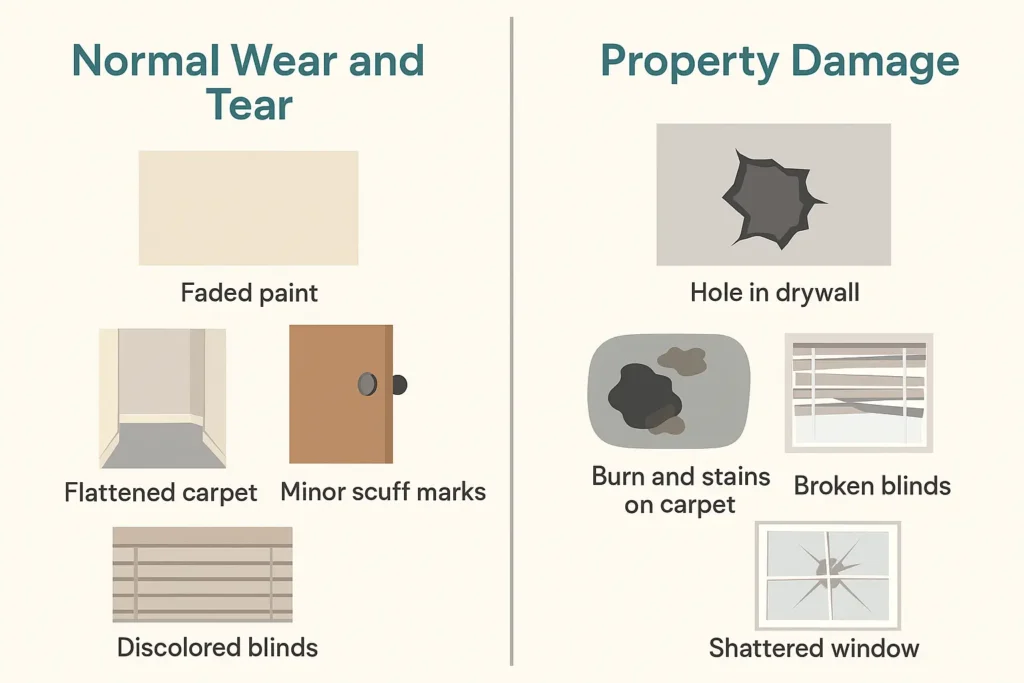You walk into your rental after a tenant moves out. The carpet’s stained, the blinds are bent, and a few nail holes dot the walls. You pause and wonder, “Is this normal wear and tear or is it damage?”
The stakes are high. Misjudging the difference could cost you hundreds in deposit disputes, or even land you in small claims court.
As a rental property owner, one of the most common (and confusing) questions you’ll face at move-out is:
“What counts as normal wear and tear versus actual property damage?”
When it’s time to process a tenant’s security deposit, knowing where the line falls between wear and tear and actual damage is essential. It protects your investment, keeps you compliant with landlord-tenant laws, and preserves professional relationships with your renters.
At SJA Property Management, we’ve been managing rental properties for over 15 years, and this is one of the most frequent and important—issues we help owners navigate. With our experience handling hundreds of move-outs across the Puget Sound area, we know just how crucial it is to distinguish between routine wear and true damage.
In this guide, we’ll break down the difference, share clear examples, and outline best practices to help you make fair, defensible decisions, backed by real-world expertise.

What Is Normal Wear and Tear?
Even the most responsible tenants leave behind signs of everyday living. Normal wear and tear refers to the gradual, natural deterioration of a property over time. It’s caused by age and regular use, not neglect or abuse.
At SJA Property Management, we’ve seen this play out countless times. For example, we’ve walked into beautifully maintained homes where the carpet in the hallway was simply worn down from daily foot traffic, or the once-bright paint in the living room had faded slightly from years of sunlight. These aren’t red flags. Rather, they’re normal, predictable outcomes of someone living in and caring for a home.
These types of issues are expected in every rental and fall under the landlord’s responsibility as part of routine maintenance.
Common examples of normal wear and tear include:
- Faded paint from sunlight
- Flattened carpet in high-traffic areas
- Slightly loose door handles or hinges
- Minor scuffs on walls
- Blinds that discolor after years of use
As experienced property managers, we remind owners that these costs are simply part of doing business. They’re not a sign of tenant neglect, but rather an inevitable part of keeping your property in top condition between leases.
Now that we’ve defined wear and tear, let’s look at what qualifies as tenant damage. These would be issues that go beyond normal use and may warrant deductions from a security deposit.
What Counts as Property Damage?
Property damage goes beyond normal use. It’s the result of tenant negligence, misuse, or failure to maintain the home properly.
We have seen just about every type of tenant damage imaginable. From doors punched through after an argument, to carpets ruined by pet urine, to kitchens where grease buildup caused cabinet warping and these aren’t the result of time, but of poor upkeep or disregard for the property.
Examples of tenant-caused property damage:
- Large holes in drywall
- Carpet burns, pet urine stains, or excessive odors
- Broken blinds or shattered windows
- Mold caused by poor cleaning or ventilation habits
- Unauthorized paint colors or wallpaper
Again, these aren’t natural aging issues. They’re preventable, and landlords in Washington State are within their rights to deduct the reasonable cost of repair from a tenant’s security deposit, as long as proper documentation is provided. We’ve helped countless owners navigate this process successfully by ensuring every deduction is fair, transparent, and well-documented.
How to Decide: Wear and Tear vs. Damage
When reviewing a move-out, the difference between wear and tear and tenant-caused damage isn’t always obvious. After managing hundreds of move-outs over the past 15+ years, we know firsthand that judgment and documentation are everything. To make a fair, defensible decision, we encourage landlords to walk through these three guiding questions:
1. Was it caused by age or normal daily living?
- If the issue is something that naturally happens over time, it falls under wear and tear, which is the landlord’s responsibility.
- Example: Faded paint, minor carpet flattening, or slightly loose door handles.
2. Was it caused by misuse, neglect, or failure to maintain?
- If the damage goes beyond what’s expected from ordinary use, it’s considered tenant damage.
- Example: Broken blinds from rough handling, large wall holes, or stains from pets or spills.
3. Would this charge hold up in court?
- Ask yourself if the deduction would be seen as reasonable and fair by an outside party. If the answer is no, it’s better not to deduct. Courts typically side with tenants when landlords try to charge for standard wear and tear.
Over the years, we’ve found that a consistent, transparent process not only keeps you compliant but also helps maintain positive relationships with outgoing tenants and a strong reputation as a fair landlord.
Pro Tip from SJA Property Management: Apply the “Reasonable Landlord” Test
Imagine another landlord looking at the same issue. Would they agree with your decision? If so, you’re likely making a fair call. If not, rethink whether the cost should come from you or your tenant.
By using this simple framework consistently, you can make confident, well-documented decisions that hold up legally, protect your property, and maintain a good reputation with tenants.
At SJA Property Management, we use this exact approach to help property owners stay compliant, minimize disputes, and maintain professional relationships that encourage long-term tenant retention.
Useful Life Guidelines for Common Property Items
Another key factor in determining whether to charge a tenant is the expected lifespan of household items. Every feature in a rental home has a “useful life,” meaning the average number of years it can reasonably last under normal conditions. If an item is already near or past that point, you generally can’t hold tenants financially responsible for replacing it, even if there’s some damage.
We’ve seen this principle come into play in countless move-outs over our 15+ years in the field. For example, we’ve had owners call concerned about stained carpets or worn paint after long-term tenancies, only to realize those items were already at the end of their expected life span. Understanding this distinction not only ensures compliance with landlord-tenant laws but also helps maintain fairness and credibility with renters.
Here are general benchmarks for useful life:
- Carpet: ~7 years
- Paint: ~2–3 years in high-traffic areas
- Water heater: ~10 years
- Major appliances (oven, refrigerator, washer/dryer): ~8–12 years
- Hardwood floors: ~25 years
- Roof shingles (asphalt): ~15–20 years
For instance, if a tenant has lived in your property for six years and the carpet shows stains, you can’t charge them the full replacement cost, since the carpet has nearly reached the end of its useful life. However, if a tenant moves out after just one year and the carpet has burn marks or pet damage, you may be justified in charging for the portion of damage that shortens its lifespan.
In our experience, applying this kind of proportional approach based on age, condition, and documentation, helps owners make reasonable, defensible decisions that stand up legally and preserve positive tenant relationships.
How to Apply Useful Life Guidelines
Understanding useful life is one thing, applying it fairly and consistently is where experience really matters. Over the past 15+ years, we’ve helped countless property owners navigate this exact process. Here’s how we recommend putting these guidelines into practice:
1. Pro-rate charges.
If an item still has some useful life left but suffers damage, only charge tenants for the remaining depreciated value, not the full replacement cost. For example, if a five-year-old carpet (with a seven-year lifespan) is ruined, you can only reasonably charge for the two years of life lost. This approach not only protects you legally but also demonstrates fairness and professionalism.
2. Be consistent.
Apply the same standards across all tenants and properties. Consistency is key to avoiding disputes or claims of unfair treatment. In our experience, maintaining clear policies and communicating them upfront during lease signing makes move-outs smoother and far less contentious.
3. Document lifespan expectations.
Keep detailed records of when items were installed, replaced, or upgraded. This documentation is invaluable during move-out evaluations, as it allows you to clearly show how much life was left in each item and justify your decisions if ever challenged.
We’ve found that tracking useful life and applying these principles consistently leads to fair, defensible, and legally compliant outcomes. It also helps set the right expectations with tenants, strengthening trust and reducing potential conflicts when it’s time to settle security deposits.
When Not to Charge Tenants
After managing properties for over 15 years, we’ve learned that knowing when not to charge tenants is just as important as knowing when to bill them. Overcharging (or charging for normal wear and tear) can create disputes, damage your reputation, and even lead to legal trouble under Washington’s landlord-tenant laws.
1. Normal Wear and Tear
Everyday aging (like faded paint, worn carpet, or a few nail holes) is part of ownership. These are landlord expenses and should be built into your maintenance budget.
2. End-of-Life Items
If a fixture or appliance is near or past its useful life, you generally can’t charge for replacement. For example, a seven-year-old carpet showing stains is considered fully depreciated.
3. Preventive Maintenance & Upgrades
You can’t bill tenants for work that benefits the property long-term, like routine cleaning or upgrades to modernize the unit.
4. Lack of Documentation
Without clear proof (photos, inspection notes, or receipts) don’t deduct from a deposit. Washington law (RCW 59.18.280) requires a detailed, itemized list with evidence.
5. Beyond Tenant Control
Don’t charge for storm damage, plumbing leaks, or structural issues, unless tenant negligence caused them.
Pro Tip:
When in doubt, apply the “Reasonable Landlord Test.”
Ask yourself, “Would another experienced landlord agree with this deduction?”
If the answer is uncertain, it’s best not to charge. In our experience, fairness and consistency always protect you more than an aggressive deduction ever will.
Quick Reference: Wear and Tear vs. Damage
Use this table as a guide when reviewing move-outs. We’ve put this together based on over 15 years of firsthand experience managing hundreds of properties and move-outs across the Puget Sound region. It highlights the most common situations landlords face and helps determine who is responsible for repair or replacement costs, saving you time, money, and potential disputes.
| Item | Wear & Tear (Landlord’s Responsibility) | Damage (Tenant’s Responsibility) |
|---|---|---|
| Carpet | Flattened in high-traffic areas, light fading | Burns, pet urine stains, excessive odors |
| Walls | Minor scuffs, small nail holes | Large holes, gouges, graffiti |
| Paint | Fading or discoloration from sunlight | Unauthorized paint colors, writing on walls |
| Doors | Loose handles, slight sticking from humidity | Broken hinges, smashed panels |
| Floors | Light scratches on hardwood, normal aging | Deep gouges, water damage from neglect |
| Blinds | Gradual discoloration over years | Bent, broken, or missing slats |
| Windows | Slightly loose seals, condensation over time | Cracks, broken glass, damaged screens |
| Appliances | Normal wear on burners, faded finish | Broken parts due to misuse, lack of cleaning |
| Plumbing | Minor mineral buildup, reduced water pressure | Clogs from foreign objects, water damage from neglect |
For more information, check out this article on rental repairs: landlord vs. tenant responsibilities.
Are Nail Holes in a Wall Normal Wear and Tear?
Yes. In most cases, small nail holes from hanging pictures or decorations are considered normal wear and tear. They’re a natural part of living in a home and fall under the landlord’s responsibility for touch-up and repainting between tenants.
However, larger holes, excessive nail marks, or damage from improper removal (such as torn drywall or wall anchors) go beyond ordinary use. Those would be classified as tenant-caused damage, and the cost of repair may be deducted from the security deposit.
A good rule of thumb:
- A few small holes per wall = normal wear and tear.
- Dozens of holes or visible wall damage = tenant responsibility.
Are Scuff Marks on Walls Considered Wear and Tear?
Yes. Light scuff marks on walls are typically considered normal wear and tear. They’re caused by everyday activities like moving furniture, brushing against walls, or regular use over time.
However, excessive marks, deep scratches, or stains that require full repainting or wall repair may qualify as tenant damage.
In general, minor scuffs = normal upkeep, while significant or avoidable wall damage = tenant responsibility.
Is a Dirty Oven Considered Normal Wear and Tear?
No. A dirty oven is not considered normal wear and tear. While light discoloration or minor residue from regular use is expected, built-up grease, burned food, or heavy grime left behind at move-out goes beyond ordinary use.
In Washington State, landlords can charge for professional cleaning if the oven wasn’t returned in reasonably clean condition, especially when the lease or move-in checklist specifies that appliances must be cleaned.
Light residue = normal use.
Caked-on grease or burnt buildup = tenant cleaning responsibility.
Can a Landlord Charge for Cleaning?
In Washington State, landlords can charge for cleaning, but only under specific conditions. The key factor is whether the property was left less clean than when the tenant moved in.
You may charge for cleaning only if:
- The cleaning required goes beyond normal wear and tear.
- The lease agreement or move-in condition report clearly states that the property must be returned in the same level of cleanliness.
Examples of valid cleaning charges include:
- Heavy grease buildup on kitchen appliances
- Dirty bathrooms with mold or soap scum
- Stained or unvacuumed carpets
- Trash or personal belongings left behind
However, you cannot charge for routine turnover tasks such as:
- Light vacuuming or dusting
- Washing windows
- General cleaning that’s part of preparing a unit for a new tenant
Always document the property’s condition before and after tenancy with photos, inspection checklists, and receipts. Under RCW 59.18.280, all cleaning deductions must be itemized and supported by evidence.
Why Documentation Matters for Security Deposits
The key to avoiding disputes over security deposits is thorough, consistent documentation. When you can show clear evidence of a property’s condition before and after a tenancy, it removes uncertainty and helps resolve disagreements quickly. Courts and mediators almost always side with the party who has better records.
Best Practices for Documentation
- Take detailed photos and videos at move-in and move-out
Capture every room, appliance, fixture, and surface. Time-stamped digital files are ideal because they provide undeniable proof of the property’s condition. - Use a comprehensive move-in/move-out checklist
Go beyond a simple “clean or dirty” review. Note the exact condition of walls, floors, appliances, plumbing, windows, and even landscaping. Ask tenants to sign the checklist so there’s mutual agreement. - Save receipts and invoices for all repairs and replacements
Keep proof of what was fixed, when, and how much it cost. This demonstrates that your deductions are fair and based on real expenses, not arbitrary estimates. - Track item lifespans
Record when major items (carpets, paint, appliances) were installed or replaced so you can fairly apply useful life guidelines. - Store records securely
Organize documentation in a digital folder or property management system for quick access if a dispute arises.
If you’re in need of documentation, check out this Rental Property Deductions Checklist for Landlords.
Legal Nuance: Know Your State’s Laws
While general guidelines can help you distinguish between normal wear and tear and property damage, it’s important to remember that landlord-tenant laws vary by state. Some states have strict rules on what can (and cannot) be deducted from a tenant’s security deposit, how quickly deposits must be returned, and what documentation is required.
For example, in certain states:
- Landlords must return the deposit within 14–21 days, while others allow up to 30–60 days.
- Some states require an itemized list of deductions with receipts attached.
- Others limit the types of deductions allowed, especially when it comes to routine cleaning or carpet replacement.
Failing to follow state-specific requirements can put landlords at risk of penalties, including
Washington State Law on Security Deposits
In Washington State, landlords are held to strict standards under RCW 59.18, and over our 15+ years managing properties, we’ve seen how critical it is to follow these rules precisely.
By law, landlords must:
- Return the tenant’s security deposit within 21 days of move-out.
- Provide a written, itemized list of any deductions.
- Include receipts or supporting documentation for all repair costs.
Failing to comply can lead to serious penalties, up to twice the amount of the deposit and can quickly turn a simple oversight into an expensive legal issue. At SJA Property Management, we’ve developed detailed inspection and documentation systems to ensure every move-out record stands up to scrutiny and protects our property owners from liability.
Can a Landlord Press Charges for Property Damage?
In most cases, property damage caused by a tenant is handled through financial deductions, not criminal charges. Landlords can deduct the cost of repairs from the tenant’s security deposit, provided the damage is documented and itemized according to Washington State law (RCW 59.18.280).
However, if the damage is intentional, malicious, or severe, for example, vandalism, destruction of appliances, or deliberate flooding, a landlord may have grounds to press criminal charges or pursue civil action for additional compensation.
Before taking legal steps, it’s wise to gather clear evidence (photos, inspection reports, repair invoices) and consult with an attorney familiar with Washington landlord-tenant law. This ensures that your response is both fair and legally defensible.
In Conclusion
The difference between wear and tear and tenant damage is one of the most common sources of conflict at move-out. But with clear expectations, consistent standards, and thorough documentation, you can protect your property while keeping relationships professional and respectful.
At SJA Property Management, we’ve overseen thousands of move-outs over the past 15+ years. Our team applies these guidelines fairly and consistently so that owners stay protected and tenants feel respected, that’s how we keep every rental experience smooth and stress-free.
Want to protect your investment and simplify property management?
Reach out for a free consultation or get started with SJA Property Management today. We proudly provide professional property management services throughout the Puget Sound area, backed by experience you can trust.







